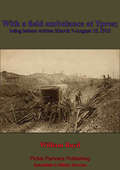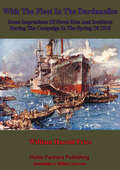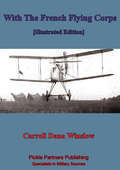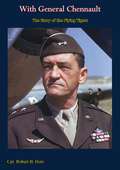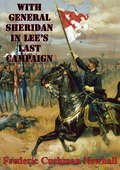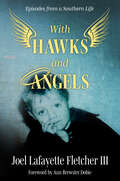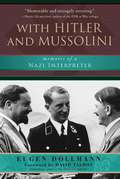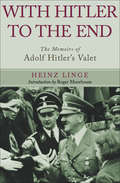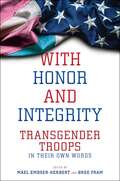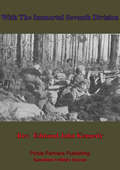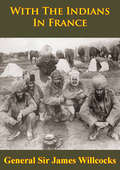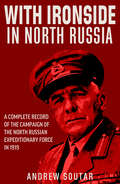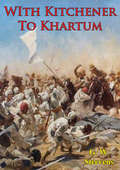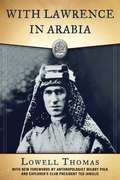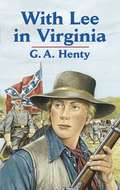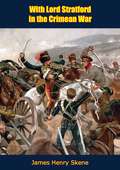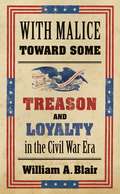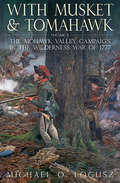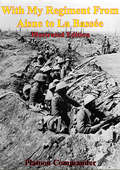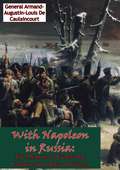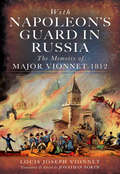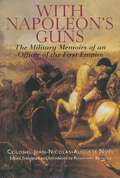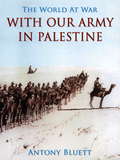- Table View
- List View
With A Field Ambulance At Ypres, Being Letters Written March 7-August 15, 1915: Being Letters Written March 7, To August 15, 1915 (1916)
by William BoydAs an Allied soldier, the Ypres salient was a hellish tongue of land to serve in during the First World War. Overlooked by German forces, surrounded on three sides by the enemies' guns, with little or no protection from the land features, it became a symbol of the stubborn resistance of the Allied soldier in the thin grim trenches. The troops faced shells, bullets, mortars, grenades and poison on a daily basis, whilst only just behind the frontline the Royal Army Medical Corps struggled to deal with the influx of wounded.Captain Boyd, as he then was, recounts his experiences in the bloody, cramped and over-worked hospitals as he attempted to save lives so brutally injured by the war. The Author went on to have an illustrious career as an internationally famed pathologist in Canada.Author -William Boyd, MB, ChB, MD, MRCP.Text taken, whole and complete, from the edition published in New York, George H. Doran company 1916.Original Page Count - 110 pages.
With The Fleet In The Dardanelles, Some Impressions Of Naval Men And Incidents During The Campaign In The Spring Of 1915
by William Harold. D. Price Sir Everard Fraser K. C. M. G.As warfare ground to a halt in the static, bloody trenches of the Western Front in 1914, the Allied command sought to lever Germany's Turkish allies out of the war. Although the British had but a small standing peacetime army, she possessed the largest fleet in the world, and planned to use the awesome power of her huge naval guns to blast a passage through the Turkish defences of the strait. Constantinople would thereby be threatened and Turkey forced to sue for peace. The plan was bold, ambitious and doomed to fail.As the confident fleet steamed up through the Mediterranean, Padre Price kept a diary of his experiences and anecdotes of the Jolly Tars. However, his notes are filled with danger and bloodshed as the fleet encounter the brave and stubborn shore batteries, taking its baptism of fire. Though gallant and bloodied by the shells of the enemy, the fleet could not force the passage - a fateful failure that would lead to the landings at Gallipoli and further allied failures. Author -- Price, William Harold. D. 1917Preface -- Sir Everard Fraser K.C.M.G. (1859-1922)Text taken, whole and complete, from the edition published in London, A. Melrose, ltd. 1915Original Page Count - xvi and 124 pages.Illustrations -- 6 Illustrations.
With The French Flying Corps [Illustrated Edition]
by Carroll Dana Winslow"Petite bleu to pilote-a young American's flight into warThe author of this book, Dana Winslow, was a young American in Paris as France recruited men to fight the invading German forces of the Kaiser at the outbreak of the First World War. Feeling strongly for the plight and cause of the French, he immediately went to Les Invalides and there enlisted in the French Flying Corps as a trainee pilot. This vital first hand account is an essential source work of the period which reveals the training of the earliest French military aviators of the great conflict on the Western Front and it follows Winslow on his 'rite of passage' from inexperienced civilian, to lowly and little regarded aeronautical student (petit bleu) through his first perilous days in the combat zone to his time as an experienced and much prized pilote in the hostile skies over the trenches of the front lines. As may be expected, Winslow takes us to his war of dogfights, mid-air collisions, artillery spotting and reconnaissance in vivid-if humbly recounted-detail. Winslow's book is especially valuable as an insight into the variety of aircraft employed by the French during his time with them and he provides useful details as to their construction, abilities, applications and flying characteristics such-as those of the peculiar 'cut down' Bleriot that was 'the Penguin.' He also gives an interesting view of the business of military flying in wartime, which he distinguishes as entirely separate from piloting, as he describes it, as a mere 'conductor.' Accounts of battling in the air during the Great War are not common, so this volume is, of course, a welcome addition to their limited number and will be of interest to everyone interested in the subject."--Leonaur Print Version.Author -- Winslow, Carroll Dana.Text taken, whole and complete, from the edition published in New York, C. Scribner's sons, 1917.Original Page Count - xi and 226 pagesIllustration -- 15 illustrations.
With Friends Like These
by Alan Dean FosterDreams of love, hate, fear and revenge come true in...WOLFSTROKER - Willie Whitehorse could have been just another boozed-up guitarist, if it hadn't been for his songs. Somehow they were different - they reached out and grabbed people's souls. Now agent Sam Parker wanted a piece of the action. But when he had it, Sam knew he'd made a terrible mistake...a mistake it was much too late to correct...WITH FRIENDS LIKE THESE... - The aliens had returned to Earth after centuries because they needed allies. But after hundreds of years, they had no idea what they would be getting the universe into...and they soon found out!DREAM GONE GREEN - Pericles was a poet and a genius, who also happened to be a horse!WHY JOHNNY CAN'T SPEED - A father could teach his son a lot of important things, but combat on the freeways wasn't one of them...not when the kit was eighteen and too full of himself to survive. But revenge did have it's compensations!
With General Chennault: The Story of the Flying Tigers
by Cpt. Robert B. HotzGeneral Claire Lee Chennault (1890-1958) was both a pioneer and a genius when it came to the development of fighter tactics. In the period between the World Wars, American aviation thinking had emphasized bombers and bomber doctrine, while the development of a fighter force and fighter tactics was downplayed. General Chennault was one of the few who perceived the potential of the fighter.Claire Chennault was a veteran pilot of the First World War, having served in the 19th Pursuit Squadron. Later he became a member of a famous Army flying acrobatic team, and also served as the Army’s chief of fighter training. Because of a hearing problem, he retired from the Army Air Force in 1937.In early 1941, he recruited a group of American fliers to fly for the Chinese in their struggle with the invading Japanese. This group was officially known as the American Volunteer Group (the AVG), but soon became legendary as The Flying Tigers—a name given to them by the Chinese. Between the periods of 20 December 1941 and 4 July 1942, The Flying Tigers demonstrated innovative tactical victories when the news in the U.S. was filled with little more than stories of defeat at the hands of the Japanese forces, and, during the lowest period of the war for both the U.S. and the Allied Forces, gave hope to America that it might eventually defeat the Japanese…
With General Sheridan In Lee's Last Campaign [Illustrated Edition]
by Lt.-Col Frederic Cushman NewhallIncludes Civil War Map and Illustrations Pack - 224 battle plans and campaign maps"Descended from English and colonial high society-Newhall lived a life of privilege and opportunity. When the war erupted Newhall enlisted in the Sixth Pennsylvania Cavalry and served his various assignments honorably as he rose through the ranks until attaining the position of assistant adjutant to General Sheridan in Feb. 1865."This memoir serves two purposes...Newhall not only rehashes the climactic days of April 1865, he acts as defense counsel for Sheridan's misunderstood character and for his contentious decision to remove Gen. Gouverneur K. Warren from command of the Fifth Corps following the Union victory at Five Forks."Newhall opens his memoir with a fiercely loyal vindication of General Sheridan the man and General Sheridan the soldier. Habits common to many Civil War soldiers like cigars and swearing were apparently comfortable within the confines of Philip Sheridan...He then seeks to secure the Union Cavalry's nascent reputation as a valuable component of the Union war effort."Newhall's rabid defense of Sheridan then subsides as he trades the pulpit for a podium. He describes in surprising detail the progressions of Five Forks and Saylor's Creek as well as the fracases, reconnaissance missions, and "rides" between the two battles. The battle descriptions emphasize the labors of the Union horsemen but do not ignore the infantry and give appropriate credit where it is due."The longest portion of the memoir not only recounts the battles fought but leads the reader on a tour of the final footsteps of both armies making temporal and spatial sense of places like Dinwiddie Courthouse, Jetersville, Burkeville, Prince Edward Courthouse, Appomattox Station, and Appomattox Courthouse. A series of maps helps the reader though this section of the memoir and is invaluable in their assistance."- Chuck Romig, The Civil War News
With Hawks and Angels: Episodes from a Southern Life (Willie Morris Books in Memoir and Biography)
by Joel Lafayette Fletcher IIIWith Hawks and Angels: Episodes from a Southern Life chronicles the fortunate life of a man born in the Cajun country of Louisiana and his interaction with the three distinct parts of his home state: the swampy, laissez-faire South where he was born, the red clay hills and piney woods of northern Louisiana where his relatives lived, and exotic New Orleans, where he was educated. Author Joel Lafayette Fletcher III examines his childhood on the campus of what is now the University of Louisiana at Lafayette where his father, Joel Lafayette Fletcher Jr., was president for twenty-five years, to his time as a student at Tulane. The book follows Fletcher through his service as a naval officer—when he began to admit to himself, accept, and explore who he really was—to his life in Europe and, eventually, Virginia where he now resides. With Hawks and Angels intimately explores the life of a young man growing up in the racially segregated Deep South while coming to terms with being gay at a time when being out was not socially acceptable. Based on his personal journals and recollections and filled with the unique characters he met along the way, With Hawks and Angels is the culmination of writing that, for Fletcher, was a way of holding onto an important part of his true self that for many years he felt compelled to hide.
With Hitler and Mussolini: Memoirs of a Nazi Interpreter
by Gerhard L. Weinberg Eugen DollmannAn insider’s view of Hitler, Himmler, Heydrich, and Mussolini.In the years before World War II, Eugen Dollmann arrived in Rome on a scholarship, intending to write a history of the Catholic Church. Instead he joined the Nazi Party and became an interpreter to various members of the German and Italian Fascist hierarchy.In this capacity Dollmann attended the Munich Conference of 1938 and was present at most of the important meetings between Hitler and Mussolini, also witnessing many of the endless squabbles between Mussolini’s son-in-law Galeazzo Ciano and Hitler’s foreign secretary, Joachim von Ribbentrop. He interpreted for Heinrich Himmler during his visits to Rome and was, curiously for one of his temperament, appointed Obersturmführer in the Allgemeine SS. He played a considerable role in the surrender of the German Army in Italy, helping to prevent the execution of Hitler’s scorched-earth orders.The book is full of piquant anecdotes-Himmler’s excavations for the legendary treasure of King Alaric; the visit of Reinhard Heydrich to the House of the Provinces, a brothel frequented by officers and men of means; Hitler’s dread and annoyance at being piloted into his newly conquered Ukraine by Mussolini-to mention only a few.Throughout, Dollmann makes no attempt to conceal or exonerate his association with the Nazis. With Hitler and Mussolini is a fascinating memoir filled with political intrigue, undercover activity, and insights into the biggest personalities connected to the Second World War.
With Hitler to the End: The Memoirs of Adolf Hitler's Valet
by Roger Moorhouse Heinz LingeHeinz Linge worked with Adolf Hitler for a ten year period from 1935 until the Fhrer's death in the Berlin bunker in May 1945. He was one of the last to leave the bunker and was responsible for guarding the door while Hitler killed himself. During his years of service, Linge was responsible for all aspects of Hitler's household and was constantly by his side. He claims that only Eva Braun stood closer to Hitler over these years. Through a host of anecdotes and observations, Linge recounts the daily routine in Hitler's household; his eating habits, his foibles, his preferences, his sense of humour and his private life with Eva Braun. In fact, Linge believed Hitler's closest companion was his dog Blondi. After the war Linge said in an interview, 'it was easier for him to sign a death warrant for an officer on the front than to swallow bad news about the health of his dog'.Linge also charts the changes in Hitler's character during the period of his service, and the latter's fading health from around 1942. During his last days, Hitler's right eye began to hurt intensely and Linge was responsible for administering cocaine drops to kill the pain. In a number of instances—such as with the Stauffenberg bomb plot of July 1944—Linge gives an excellent eyewitness account of events. He also gives thumbnail profiles of the prominent members of Hitler's 'court': Hess, Speer, Bormann and Ribbentrop amongst them. Though Linge held an SS rank, he claims not to have been a Nazi Party member. His profile of Hitler is not blindly uncritical, but it is nonetheless affectionate. The Hitler that emerges is a multifaceted individual: unpredictable and demanding, but not of an otherwise unpleasant nature.
With Honor and Integrity: Transgender Troops in Their Own Words
by Máel Embser-Herbert Bree FramHeartfelt personal accounts from transgender people fighting for the right to serve in the military “Prior to coming out as transgender I served the first several years of my career under “Don’t Ask, Don’t Tell,” hiding my sexual orientation out of the constant fear of expulsion. I then found myself in the same predicament as when I first joined, wanting nothing more than to serve my country and do my job, but at the cost of sacrificing a major part of who I am. . . . This time, however, I decided that I could no longer sacrifice my own well-being, my own authentic self.”—Mak Vaden, Warrant Officer 1, U.S. Army National Guard, 2006-present“I have traveled around the world. . . . I have been on five cutters with eleven years of sea time and commanded the Coast Guard cutter Campbell. I have negotiated treaties and fostered international law enforcement cooperation. I have stopped drug smugglers and seized illegal fishing vessels on the high seas. And, I also have gender dysphoria and identify as a trans woman.”—Allison Caputo, Captain, US Coast Guard, 1995–presentOn January 25, 2021, in one of his first acts as President, Joe Biden reversed the Trump Administration’s widely condemned ban on transgender people in the military. In With Honor and Integrity, Máel Embser-Herbert and Bree Fram introduce us to the brave individuals who are on the front lines of this issue, assembling a powerful, accessible, and heartfelt collection of first-hand accounts from transgender military personnel in the United States. Featuring twenty-six essays from current service members or veterans, these eye-opening accounts show us what it is like to serve in the military as a transgender person. From a religious affairs specialist in the Army National Guard, to a petty officer first class in the Navy, to a veteran of the Marine Corps who became “the real me” at age forty-nine, these accounts are personal, engaging, and refreshingly honest. Contributors share their experiences from before and during President Trump’s ban—what barriers they face at work, why they do or don’t choose to serve openly, and how their colleagues have treated them. Fram, a lieutenant colonel who is serving openly as a transgender woman in the US Space Force, and has advocated for open service policies, shares her experience in the aftermath of Trump’s announcement of the ban on Twitter. Ultimately, Embser-Herbert and Fram provide an inspiring look at the past, present, and future of transgender military service. At a time when LGBTQ rights are under siege, and the right to serve continues to be challenged, With Honor and Integrity is a timely and necessary read.
With Hope and Love (The Cliffehaven Series #17)
by Ellie DeanTHE SEVENTEENTH CLIFFEHAVEN NOVEL BY SUNDAY TIMES BESTSELLING AUTHOR ELLIE DEAN. ______________________________Cliffehaven, 1945The war in Europe is over, but for Peggy Reilly and the residents of Beach View Boarding House the effects of the conflict are still far-reaching.Cockney evacuee, Ivy, and her sweetheart, Andy, are saving to get married and fulfil their dream of returning to the East End. But when tragedy strikes, Ivy is faced with a life-changing dilemma that only she can resolve. Rita also faces an impossible choice when her sweetheart Peter proposes and asks her to live with him in Australia - just as her widowed father returns from the fighting in Europe.Meanwhile Peggy must say goodbye to several of her evacuee chicks whilst she awaits the return of her family from Somerset and the news that her husband, Jim, can finally come home.It's a dream she has held onto for six long years, but fate has one more twist in store. . .
With The Immortal Seventh Division
by Right Reverend the Lord Bishop of Winchester Rev Edmund John KennedyEven among the highly-trained and professional soldiers of the B.E.F in 1914 the men of the Seventh division stood apart for their bearing and training, for the contained no reservists; all were full-time soldiers. Accompanying these uncompromising men, was Reverend Kennedy, assigned to the 20th Brigade, which was to see much action during the opening months of the First World War.The Padré and his beloved soldiers trekked into Belgium to take part in the First Battle of Ypres, to find the local inhabitants welcoming but the atmosphere filled with apprehension. As the Seventh finally clashed with the invading Germans the author found his role turned from an observer to participant in offering comfort and even absolution to the wounded and dying. A man of committed faith he continued to minster to his men as they fought in the desperate action around Ypres.After a year with the troops the Reverend returned to England and composed his memoirs of the period but did not survive long enough to see their publication.Author -- Rev. Edmund John Kennedy d. 1915.Preface -- Right Reverend the Lord Bishop of Winchester.Text taken, whole and complete, from the edition published in London, Hodder and Stoughton, 1916.Original Page Count - x and 193 pages
With The Indians In France
by General Sir James Willcocks GCB GCMG KCSI DSOThe memoirs of Sir James Willcocks stand apart from other diaries and recountings of senior British Officers on the Western Front during the First World War; although a British Gentleman, his heart had long been taken by charms of India. Willcocks was a long serving officer in the Indian Army and led his men all the way from Nepal, Scinde, the Punjab and Bengal to the mud and blood of the trenches in Northern France and Belgium.The fighting prowess and sacrifice of these brave Indian soldiers has often been forgotten tale, but their commanding General tells of their efforts and victories with justified pride throughout his work which covers the early months of the war until his resignation in late 1915. The Indian Corps was heavily engaged throughout at la Bassée, Messines, Armentières, Neuve Chapelle, Aubers Ridge and Festubert and finally at the brutal blood-letting during the battle of Loos.
With Ironside in North Russia (Russia Observed Ser.)
by Andrew SoutarWith Ironside in North Russia, first published in 1940, is the account of Britain and her Allies’ valiant but futile attempt to militarily protect Russians opposed to the Communist Bolsheviks in Russia in 1919. Author Andrew Soutar (1879-1941) was a journalist for the London Times assigned to cover Brigadier-General Edmund Ironside and his Allied Expeditionary Force in northern Russia, near the city of Archangel. He traveled with the General and made many excursions in the field to visit soldiers, hospitals, prison camps, and native villages. The book provides a firsthand account of the struggle against the Red Army, the hardships caused by weather extremes, the struggle to move men and equipment, and an overview of the political situation. Included are 20 pages of illustrations.
With Kitchener To Khartum [Illustrated Edition]
by George Warrington SteevensIllustrated with 15 mapsGeorge Warrington Steevens was among the most prominent journalists of the Victorian era; writing articles for the National Observer, Pall Mall Gazette and the newly founded Daily Mail; by far his most famous book was 'With Kitchener to Khartum'. As close member of Kitchener's inner circle, he saw and wrote of the famous campaign in Sudan, variously known as the Madhist Revolt, or the Second Anglo-Sudan War of 1896-1899.As Steevens recounts in inimitable detail, Kitchener, having become Sirdar or commander of the Egyptian Army set out to recapture the Sudan and avenge his hero Gordon, who had been murdered by the Mahdi some years earlier. As Kitchener and his force descended the Nile, with Steevens in tow, they took great care to ensure their line of supply building a railway line as they went and supplied by river flotilla. The first main clash of forces was at the Battle of Atbara in April 1898 where the British and Egyptian forces furiously attacked and routed a Sudanese camp. Kitchener's greatest hour came at the battle of Khartoum, four months later, when confronted with a vastly larger force, he relied on the firepower of disciplined volleys and machine guns to break the rebel army beyond repair. Although the revolt lasted a little while longer into 1899, Kitchener could rightly claim to be the victor of the campaign and was ennobled Lord Kitchener of Khartoum.An excellent account of a pivotal Imperial campaign.
With Lawrence in Arabia (Explorers Club Classics)
by Lowell Thomas Mitchell StephensIn 1918, as the First World War ravaged the European continent, young American journalist Lowell Thomas traveled to the Ottoman Empire to report on the revolts breaking out as an indirect result of the savage European conflict. While in Jerusalem, he met and struck up a friendship with the infamous young British captain, T.E. Lawrence. Based on his travels and interviews with Lawrence, Thomas wrote the now classic With Lawrence in Arabia, the book that spawned the Lawrence of Arabia legend and served as the basis for the award-winning 1961 film of the same name.Fantastically paced with equal measures of fact and adventure, Thomas narrates the exploits of the infamous British agent who against all odds managed to join several factious Arabian tribes into a single combat unit. With Lawrence in command, this guerilla force would go on to defeat the great Turkish Army and ensure the eventual demise of the previously impenetrable Ottoman Empire.On the sweeping and the exotic Arabian desert that serves as the setting for this epic account, Thomas brings to life dozens of great historical figures including Emir Feisel, King Hussein I of Hedjaz, British General Edmund Alleby, and Lawrence, the enigmatic, "modern knight of Arabia.” With new forewords by modern explorers, this Explorer’s Club Classic edition of With Lawrence in Arabia is a must-have for every history buff and arm-chair adventurer.
With Lee in Virginia: A Story Of The American Civil War (The Land of Oz)
by G. A. HentyIn this spirited tale of adventure, Vincent Wingfield, who is not yet sixteen, returns home to Virginia after four years of school in England to find conditions in America greatly unsettled. When war breaks out in 1861, Vincent staunchly supports the rights of slaves but joins Lee's cavalry to fight for the Confederacy.Henty's gripping story, written several decades after the war, weaves the spirited teenager's adventures with real-life events, while providing an acute glimpse of the conflict from a Southern perspective.A prolific 19th-century author, G. A. Henty celebrates family, honor, loyalty, bravery, and determination in the face of adversity. Set against the backdrop of an exciting historical era, this story, recently rediscovered by young readers, will excite the imaginations of today's youngsters as much as it thrilled readers when first published.
With Lord Stratford in the Crimean War
by James Henry SkeneA fascinating view of the Crimean War from an aide to the controversial Stratford Canning, ambassador ambassador to the Ottoman empire.Stratford Canning, 1st Viscount Stratford de Redcliffe, KG, GCB, PC (1786-1880) was a British diplomat and politician, best known as the longtime British Ambassador to the Ottoman Empire. In 1841 he was re-appointed Ambassador to the Ottoman Empire, a position he held for the next 17 years. Lord Stratford came to be seen as one of the leading figures in Constantinople, as British influence over the Porte increased and the Turks came to be seen more and more as British clients.
With Malice toward Some
by William A. BlairFew issues created greater consensus among Civil War-era northerners than the belief that the secessionists had committed treason. But as William A. Blair shows in this engaging history, the way politicians, soldiers, and civilians dealt with disloyalty varied widely. Citizens often moved more swiftly than federal agents in punishing traitors in their midst, forcing the government to rethink legal practices and definitions. In reconciling the northern contempt for treachery with a demonstrable record of judicial leniency toward the South, Blair illuminates the other ways that northerners punished perceived traitors, including confiscating slaves, arresting newspaper editors for expressions of free speech, and limiting voting. Ultimately, punishment for treason extended well beyond wartime and into the framework of Reconstruction policies, including the construction of the Fourteenth Amendment. Establishing how treason was defined not just by the Lincoln administration, Congress, and the courts but also by the general public, Blair reveals the surprising implications for North and South alike.
With Musket & Tomahawk Volume II: The Mohawk Valley Campaign in the Wilderness War of 1777 (With Musket & Tomahawk Series #2)
by Michael O. LoguszThis history of the 1777 Wilderness War in America&’s fight for independence chronicles the Patriot defense against British and Iroquois attackers. Continuing his acclaimed history of the battles for New England during the Revolutionary War, Michael Logusz chronicles the British Army&’s campaign from Lake Ontario down the Mohawk Valley. This campaign, led by Gen. Barry St. Leger, was perhaps the most terrifying of all, as it overran a sparsely populated wilderness where colonists had long needed to bear arms against the Iroquois Federation. Yet now, the British had made common cause with the Iroquois, forming an even more fearsome enemy. In upstate New York, the Patriot Fort Stanwix held fast, though surrounded by St. Leger&’s forces and his Mohawk and Loyalist auxiliaries. Some eight hundred Patriots under militia leader Nicholas Herkimer attempted to relieve the fort, but were ambushed en route in the Battle of Oriskany, the basis for the movie Drums Along the Mohawk. In the end, Fort Stanwix was relieved only when Benedict Arnold marched his troops through and forced the British to give up their western onslaught. In With Musket and Tomahawk Volume II, Logusz captures the terrain, tactics, and terror of this multifaceted wilderness war.
With My Regiment From Aisne to La Bassée [Illustrated Edition]
by Arthur F. H. MillsIncludes the First World War Illustrations Pack - 73 battle plans and diagrams and 198 photosOriginally published under the pseudonym "Platoon Commander" these excellent memoirs were written by the noted novelist Arthur F. H. Mills after his service in the British Expeditionary Force in 1914-1915. "In the early summer of 1914, apparently unconcerned by the gathering storm and the colossal building of military might in Germany, the British regular army, reduced in numbers and not having fought a major conflict for over a decade, was at peace in its garrisons. When German troops marched through Belgium and attacked France, the British Expeditionary Force was hastily created and for British soldiers the transition from peace to mobilisation and transportation to the battle line happened within a matter of days. It is astonishing that the 'Contemptible Little Army' was not instantly enveloped by the advancing Germans who outnumbered them--often by much more than five to one. Some are jingoistic about the British Army of the day being 'the best army in the world,' however, the battle fought at Mons, the retreat to the Marne, the skilful command of the British staff and the dogged resistance of troops, who inflicted causalities on the enemy totally disproportionate to their strength, speaks for itself. The outcome was inevitable though and by the early months of 1915 the B. E. F. had all but been destroyed. Its tenacity had, however, earned the British sufficient time to build a new army, defence and response."-Print ed.
With Napoleon in Russia: The Memoirs of General De Caulaincourt, Duke of Vicenza [Illustrated Edition]
by George Libaire Jean Hanoteau General Armand Augustin Louis de CaulaincourtIncludes over 180 illustrations, portraits and maps covering the Russian Campaign of 1812."These Memoirs are the findings of a professional soldier, sitting in judgment upon the foremost soldier of fortune the world has known. But they are something more than that. They are the observations of a man of the Old Régime, whose lot had been cast in with the new Empire. The soldier who wrote them was a statesman as well--a diplomatist of the school of Talleyrand, but without any of that strange creature's womanish ways. He was also--and one often feels the lack of this quality in memorialists who were near Napoleon--an administrator of sufficient skill to comprehend the Emperor's plans, and to do justice to the recording of them. And finally, he was a man with physical energy enough to match, and on occasion to outdo, the Emperor's own."
With Napoleon's Guard in Russia: The Memoirs of Major Vionnet, 1812
by Louis Joseph VionnetMajor Louis Joseph Vionnets memoirs of Napoleons disastrous 1812 campaign in Russia are readable, detailed, and full of personal anecdote and vivid glimpses into the life of the nineteenth-century soldier. His account concentrates in particular on the retreat from Moscow, but he was present at all the major actions and followed the entire course of the campaign from the opening moves in July 1812 to being chased through Prussia by bands of Cossacks in early 1813. He was present at the destruction of Smolensk, toured the battlefield of Borodino and witnessed the great fire in Moscow. Vionnet was a major in the Fusiliers-Grenadiers, a regiment of veterans in the Imperial Guard, and his account provides a wonderful insight into the lan, morale and cohesion of this elite fighting force. Jonathan North has translated Vionnets memoirs for the first time for this English edition. In addition to providing detailed explanatory notes, he quotes from the accounts left by five other soldiers from the same regiment, and these extracts allow the reader to follow the ups and downs of the unit as a whole. Louis Joseph Vionnet, Vicomte de Maringon, was born in Longueville in 1769, the son of a peasant and a lace maker. He joined the artillery in 1793 and was promoted to captain in the line in 1794. He fought in Italy in 1796, in the line infantry in 1798 and the Guard grenadiers in 1806, and campaigned in Prussia, Poland and Spain. In 1809, he joined the Fusiliers of the Guard, fought again in Spain in 1811 and then, with the rank of major, he took part in the 1812 Russian campaign, which he survived. He retired in the 1830s and died in 1834.
With Napoleon's Guns: The Military Memoirs of an Officer of the First Empire
by Colonel Jean-Nicolas-Auguste NoëlIn 1795 - the year Napoleon Bonaparte was appointed commander-in-chief in Italy - the seventeen-year-old Jean-Nicolas-Auguste Noel entered the Artillery School at Chalons. A year later, with Napoleon proclaiming himself the liberator of Italy, Noel was appointed second lieutenant in the 8th Regiment of Horse Artillery. Written in 1850, With Napoleon's Guns is his remarkable memoir of twenty years in the Emperor's service. A trained artilleryman himself, Napoleon dramatically transformed the role of the artillery from a cumbersome and tactically limited force into fluid, independent and highly mobile trains d'artillerie. This new organisation required fresh new officers - officers with intelligence who could act under their own initiative: officers such as Noel. From the optimism of the early years in Italy, through the privations of the retreat from Moscow and the horrors of the Battle of Leipzig, to the disillusionment of the Emperor's decline, Noel charts both his personal career and, at close hand, the trajectory of the First Empire with frankness and percipience.Based on the journal he kept from his cadetship at Chalons, With Napoleon's Guns is a dignified and revealing account of an officer at the heart of Napoleon's army.In 1795 - the year Napoleon Bonaparte was appointed commander-in-chief in Italy - the seventeen-year-old Jean-Nicolas-Auguste Noel entered the Artillery School at Chalons. A year later, with Napoleon proclaiming himself the liberator of Italy, Noel was appointed second lieutenant in the 8th Regiment of Horse Artillery. Written in 1850, With Napoleon's Guns is his remarkable memoir of twenty years in the Emperor's service. A trained artilleryman himself, Napoleon dramatically transformed the role of the artillery from a cumbersome and tactically limited force into fluid, independent and highly mobile trains d'artillerie. This new organisation required fresh new officers - officers with intelligence who could act under their own initiative: officers such as Noel. From the optimism of the early years in Italy, through the privations of the retreat from Moscow and the horrors of the Battle of Leipzig, to the disillusionment of the Emperor's decline, Noel charts both his personal career and, at close hand, the trajectory of the First Empire with frankness and percipience.Based on the journal he kept from his cadetship at Chalons, With Napoleon's Guns is a dignified and revealing account of an officer at the heart of Napoleon's army.In 1795 - the year Napoleon Bonaparte was appointed commander-in-chief in Italy - the seventeen-year-old Jean-Nicolas-Auguste Noel entered the Artillery School at Chalons. A year later, with Napoleon proclaiming himself the liberator of Italy, Noel was appointed second lieutenant in the 8th Regiment of Horse Artillery. Written in 1850, With Napoleon's Guns is his remarkable memoir of twenty years in the Emperor's service. A trained artilleryman himself, Napoleon dramatically transformed the role of the artillery from a cumbersome and tactically limited force into fluid, independent and highly mobile trains d'artillerie. This new organisation required fresh new officers - officers with intelligence who could act under their own initiative: officers such as Noel. From the optimism of the early years in Italy, through the privations of the retreat from Moscow and the horrors of the Battle of Leipzig, to the disillusionment of the Emperor's decline, Noel charts both his personal career and, at close hand, the trajectory of the First Empire with frankness and percipience.Based on the journal he kept from his cadetship at Chalons, With Napoleon's Guns is a dignified and revealing account of an officer at the heart of Napoleon's army.
With Our Army in Palestine (The World At War)
by Antony BluettA fascinating book by a British soldier who tells of the efforts in WWI in the Middle East. This was a time when much of the battling was with bayonet and face to face. There are a lot of interesting facts of the brutality of that war. Toward the end he mentions that 60,000 people died of starvation in 'Beyrout' during the War out of a population of 80,000. (Excerpt from Goodreads)
